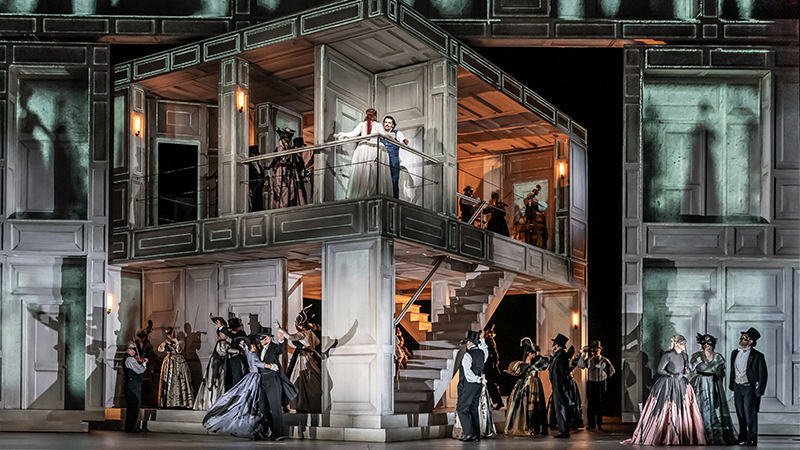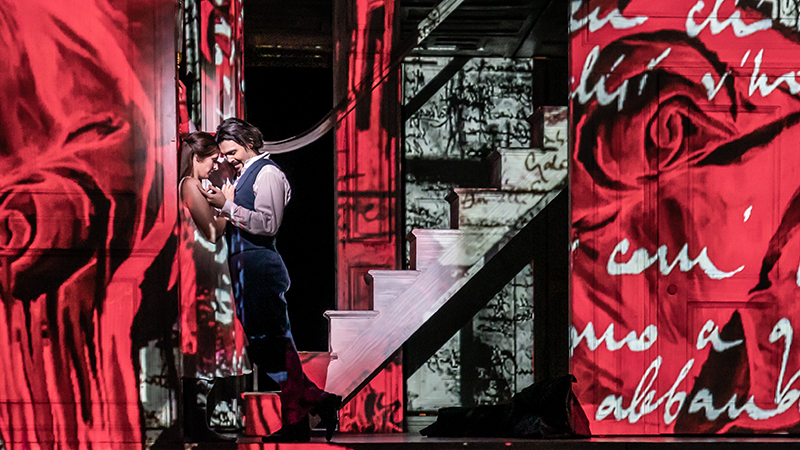
Mozart’s
Don Giovanni is a towering musical accomplishment and widely considered to be one of the greatest operatic works ever composed. The music is thrilling, complex, and elegant, offering many interpretations of the nefarious title character—from farcical blasphemer and incorrigible libertine to romantic hero and unrepentant egotist.
On viewing the original manuscript for
Don Giovanni in June 1886, Russian composer Tchaikovsky described himself as being "in the presence of divinity.” Read on to discover what makes the work so striking to musicians and audiences alike.
Spoiler alert: the following content contains plot points that some audience members may not wish to know in advance!BUY TICKETS
From the opening notes, it’s clear that Don Giovanni is unique among operas: a dark comedy that draws on violent and supernatural elements to chart the downfall of its predatory antihero. Two powerful chords launch the overture in the key of D-minor, only to later shift into D-major—a clear signal that audiences will be taken on a journey that veers constantly between comedy and dark drama.
Mozart’s genius for characterization is on full display in the music of
Don Giovanni—not only in its solo arias but also in duets, trios, and ensemble pieces. An early example occurs in the first act, where the melody sung by the spurned and vengeful Elvira is contrasted with the lightness of Don Giovanni’s dismissive reply. Mozart also throws in some musical special effects, including a mandolin with pizzicato (plucked) strings to highlight the serenading scene at Elvira’s window.
There are opportunities galore for the singers to display their vocal agility. Perhaps the best-known example is Leporello’s “Catalogue Aria": a popular classic, undoubtedly representative of the social norms of its time, which nevertheless spotlights the title character’s extreme misogyny. In this piece, Don Giovanni’s servant lists his master’s conquests, accompanied by staccato orchestration that imitates a counting machine. The music adjusts to reflect the different “types” of woman that Don Giovanni loves—drawing on a theme from Act I emphasising Leporello’s loyalty to illustrate the “constancy” he admires in brunettes, and incorporating a courtly minuet to evoke the “gentility” he associates with blondes.

Another musical highlight from the opera is “Là ci darem la mano” (“There we will join our hands”), which puts on full display Don Giovanni’s skill at the art of seduction. As he offers Zerlina empty promises about marriage and wealth, Don Giovanni ignores her coy protestations and encourages her to repeat everything he says until the two conclude the duet together.
But perhaps the most notable musical moment of the entire opera occurs in the ballroom scene at the end of Act I, when two on-stage groups play separate pieces, in different metres, in synchronization with the orchestra. The three different dance melodies are used to represent the social strata featured in the opera: a stately minuet—a slow ballroom dance—stands in for the nobles, a rustic follia (or folk dance) plays for the ordinary guests, and a lively allemande—another traditional, partnered dance—harkens to the peasants and servants.
To sample the unforgettable music of
Don Giovanni, check out this clip from our 2023/2024 Season Preview Concert, featuring Midori Marsh and Alex Halliday singing "Là ci darem la mano.”
Mozart's
Don Giovanni runs from February 2 – February 24, 2024 at the Four Seasons Centre for the Performing Arts.
BUY TICKETS
Photos: Marc Brenner


